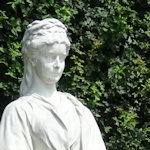
Ah, Sisi, the 19th-century Empress who still inspires adulation and artists. Sportswoman, fashion icon, traveller, poet, friend to the Hungarians, and tragic victim of an assassin’s blade.
Elisabeth’s name and face appears all over modern Vienna. But how much of her story and reputation is real and how much myth?
Here’s an overview for those unfamiliar with her life.
- Married Emperor Franz Joseph at 16
- Revered for her beauty and accomplishments
- A contentious figure at court
- Troubled by health issues
- Central figure at palace attractions
- Book a guided Sisi-themed tour*
- See also:
Who was Empress Elisabeth?
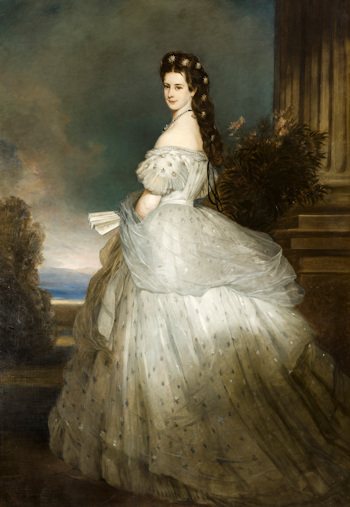
(Franz Xaver Winterhalter, Kaiserin Elisabeth, undated; perhaps the most famous portrait of the Empress; photo courtesy of Belvedere’s Open Content Policy)
The innocent question in the heading proves quite difficult to answer. We have the biographical details, but Elisabeth’s personality remains rather enigmatic.
You might consider Sisi (as she is commonly known) the most famous female in Habsburg history. She escaped the bindings of reality to become an iconic figure of beauty and legend.
But let us begin with the facts…

(Elisabeth pictured by Franz Seraph Hanfstaengl (Hanfstängl) in 1853; Wien Museum Inv.-Nr. 82831; excerpt reproduced with permission under the terms of the CC0 licence)
Elisabeth was born on December 24th, 1837, in Munich, into an offshoot of the Bavarian royal family. She enjoyed a relatively untroubled free-spirited upbringing until fate intervened in 1853 at a meeting with the Austrian emperor, Franz Joseph.
That meeting sought to cement an arranged marriage between the monarch and Elisabeth’s older sister.
Cupid, though, twanged his bow rather inaccurately, and the young Emperor found himself head over heels in love with Elisabeth instead.

(The Augustinerkirche church where the imperial couple married)
Once various court feathers had been appropriately smoothed, Franz Joseph and Sisi married in Vienna in 1854.
Incidentally, the Emperor’s overbearing mother (Sophie) disapproved of the union and would prove to be a less-than-accommodating mother-in-law.
And so our young princess became a fully-fledged Empress, swapping her Bavarian idyll for the rules and rigours of the imperial Vienna court. And that at the tender age of just 16. Which might explain much of what followed.

(A photo of the empress from around 1863/1864 by Ludwig Angerer; Albertina, Austria; Public Domain)
To cut a long story short, Elisabeth never took to the staid inflexibility of the court and largely ploughed her own way through life until her untimely death; an anarchist, Luigi Lucheni, assassinated her in Geneva on September 10th, 1898.
The nature of that life and the woman who lived it has given rise to the iconic Sisi image that prevails today.
Even at the time, the Empress was widely regarded through much of the continent as one of the most beautiful and accomplished women of her era.
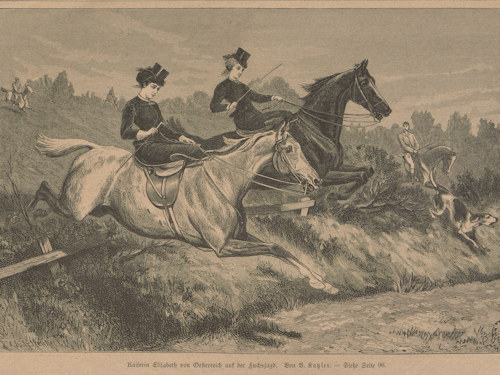
(Empress Elisabeth fox hunting, 1882; Vinzenz Katzler (artist), Wien Museum Inv.-Nr. W 7983; excerpt reproduced with permission under the terms of the CC0 licence)
Elisabeth herself had a (likely unhealthy) obsession with her looks, figure, and ankle-length hair. She exercised rigorously and dieted excessively whenever she felt her weight rising above her idea of optimal; the width of the waist on some of her dresses is frankly terrifying.
The Empress’s accomplishments almost matched her beauty. Her horse-riding skills ranked her as possibly the best female equestrian in Europe, for example. She also wrote poetry (with less success).
The obsession with fitness and body shape is one of many issues that make Sisi’s personality complicated.
Early in Elisabeth’s marriage, for example, the confines of court and the control mania of her mother-in-law drove her to sickness, and she suffered bouts of melancholy throughout her life (not helped by the early deaths of her first child, Sophie, and her only son, Crown Prince Rudolf).
Seemingly in a state of near-permanent restlessness, Sisi spent much of her time away from Vienna to the disappointment of the court, her husband, and many of her more conservative subjects: a free spirit constantly fleeing convention, responsibility, and tradition.
Why is Sisi important?
Empress Elisabeth left her stamp on Vienna’s cultural memory.
This beautiful, artistic, troubled woman has legendary status both in Austria and (particularly) abroad, as any glimpse inside museum and souvenir shops reveals.
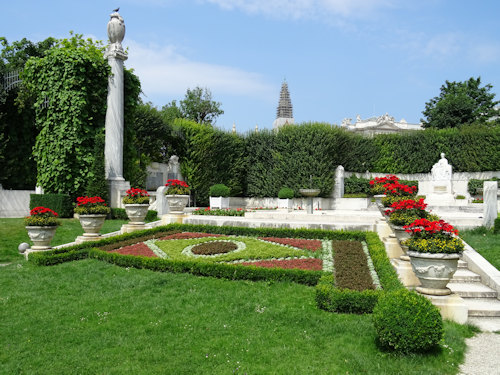
(The Elisabeth memorial in the central Volksgarten area)
During Sisi’s lifetime, the Hungarians held her in particularly high regard, not least because she supported their autonomy as the Austrian empire morphed into Austria-Hungary.
Elisabeth’s story and eventful life has inspired numerous books, films (like Corsage), TV series and even musicals and operas, not all of which score high points for historical accuracy.
The Elisabeth / Franz Joseph romance, for example, was not nearly as Disneyesque as many believe. The Emperor did indeed worship his wife, but the feeling could not be described as mutual.
We do like a good tale, though, and the rise of Sisi from minor Bavarian nobility to Empress of Austria ticks many of the right narrative boxes: love, royalty, drama, loss, and tragedy, for example.
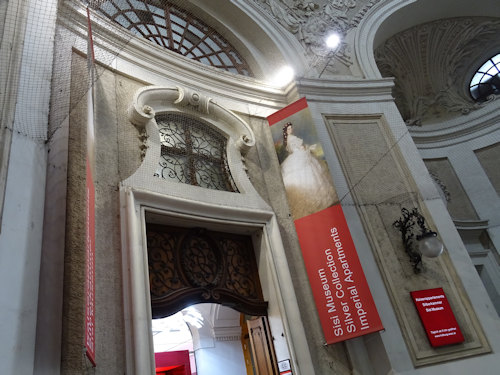
(Entrance to the Sisi Museum, which traces her biography and character with numerous displays, original items and reconstructions)
Combine that story with Elisabeth’s looks and personality, and you have an ongoing source of fascination for many people.
Visit the Empress’s coffin in the Kaisergruft, for example, and you invariably find fresh flowers there. A 2024 auction of some of her possessions saw a riding crop sell for €16,900, a fan for €9,100, and a velvet jacket for €62,400.
Equally, Sisi’s life has left large footprints on Vienna’s tourism landscape. For example:
- Tours of the Schönbrunn and Hofburg palaces take in the Empress’s apartments
- She has her own museum, exhibition, themed guided tour*, and memorial
- She makes appearances in various virtual reality displays (I have a soft spot for Sisi as tour guide in the Amazing Journey VR experience)
Should you wish to follow in those footprints more closely, see my whole article on recommended Sisi locations.